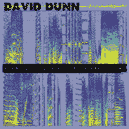 David
Dunn
"Four Electroacoustic Compositions" CD
Pogus
Productions
Genres: electroacoustic, experimental, avant-garde
Pogus Productions
50 Ayr Road
Chester, NY 10918
Oct 14 - 20 2002 |
Electroacoustic music, while one of the most diverse and interesting
forms of sound, often goes unnoticed and ignored by listeners at large.
While this isn't all that surprising, given the experimental nature of
the genre, one would argue that such groundbreaking work is worthy of
more recognition that it is given. David Dunn's latest effort, a
collection of four electroacoustic compositions, is a stunningly
intriguing work that will hopefully garner some attention from
experimental music enthusiasts.
Knowing Dunn's past, it comes as no surprise that these four
compositions are successful. In the early seventies, Dunn worked
with Harry Partch and from there evolved into a respected
experimental audio performer, composing various music installations and
studying in the field of bioacoustics. These experiences have obviously
affected his work as we hear it today.
"...with zitterings of flight released (in memoriam Kenneth
Gaburo)," the first of the compositions, is a fourteen-minute piece
of heavily-processed short audio fragments that were created by a unique
analogue synth callled the Vividium MKII. This machine produced a number
of extraordinarily complex sounds that were then digitally edited by an
audio workstation. The result is an infinitely interesting and diverse
sound sculpture that is made up of numerous electronic sounds and
noises.
"Simulation 1: (Sonic Mirror)," on the other hand, is an
electronic manipulation of various environmental sound samples captured
in the Cuyamaca Mountains of California. Throughout the composition, you
can hear both the digitalized audio reworkings of the noise and the
original field recorded sources. The meeting of the two are what makes
this such a wonderful, groundbreaking audio experiment.
"Wildflowers," the third work on this CD, is an exploration
of analogue-based sounds, with Dunn attempting a
"reclamation of the sounds of circuitry as material
substance." While he admits such audio work is done more for
nostalgic value than anything else, and that sounds of its type are now
only relevant in the context of video games, "Wildflowers"
remains an enjoyable, though blatantly quixotic look at the starts of
"computer music."
The collection closes off with "Ennoia 2," a
computer-generated piece that is based upon the algorithms created by Arun
Chandra's waveform synthesizing Wigout program (http://grace.evergreen.edu/~arunc/).
In the over ten-minute composition, the sound is left to evolve, with
its waveform patterns being determined by the trends in the Fibonacci
sequence (the naturally-occurring pattern that forms spirals when
graphed geometrically.) The piece is given much depth by the fact that
two different versions of the piece are played over each other, each one
seperated by a few changes in the initial waveform state combinations.
The track manages to be surprisingly relaxing, and the spiral patterns
are very evident.
Altogether, David Dunn's four compositions are very powerful
and thought-provoking. His attention to detail and audio precision
proves that he is a very intelligent sound conceptualist, and these four
pieces will appeal to both experimental music enthusiasts and
electroacoustic researchers.
88%
Matt Shimmer [Vitals:
53 min 55 sec; 4 tracks; distributed by the
label;
released 2002] |